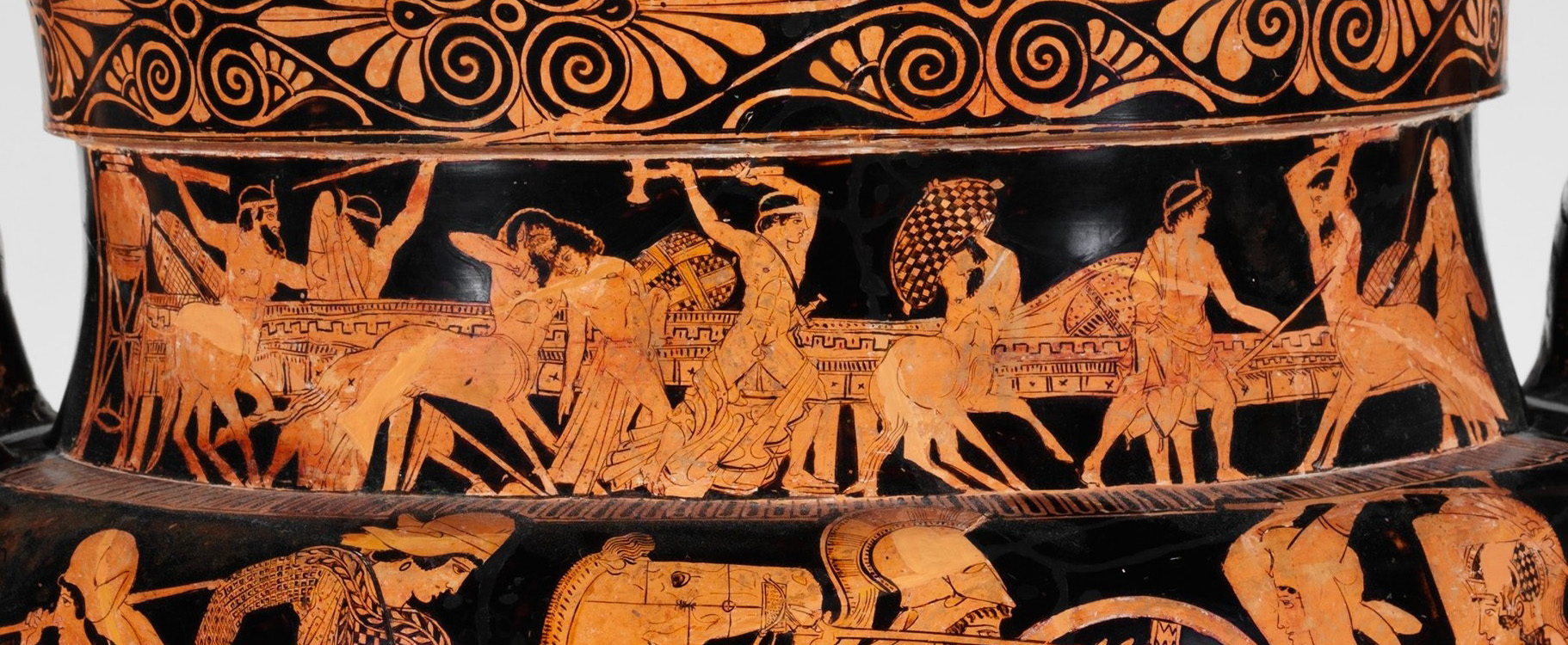Chapter 9: Theseus’ Later Exploits
Previous Page Table of Contents Next Page
♠ Pindar fr 166 SM – Pindarus 2, p. 121, ed. B. Snell and H. Maehler. Leipzig 1975.
When the Centaurs knew the man-taming smell of honey-sweet wine, they impetuously hurled the white milk from the tables and, drinking of their own freewill from silver horns, they were becoming drunk… (Transl. Aaron J. Ivey)
Florence, Museo Archeologico Nazionale 81268 (3997): Attic red-figure column krater with wedding of Peirithoos:

A. Furtwaengler and K. Reichhold, Griechische Vasenmalerei: Auswahl hervorragender Vasenbilder (Serie III, Tafel 121-180, 1932), pl. 166.2
Beazley Archive Pottery Database
Berlin, Antikensammlung F2403: Attic red-figure volute krater fragments with wedding of Peirithoos

♠ Paus 1.17.2 – Pausanias, Description of Greece
Hard by the gymnasium [in Athens] is a sanctuary of Theseus, where are pictures of Athenians fighting Amazons. This war they have also represented on the shield of their Athena and upon the pedestal of the Olympian Zeus. In the sanctuary of Theseus is also a painting of the battle between the Centaurs and the Lapithae. Theseus has already killed a Centaur, but elsewhere the fighting is still undecided. Greek Text
♠ Paus 5.10.8 – Pausanias Description of Greece
The sculptures in the front pediment [of the temple of Zeus at Olympia] are by Paeonius, who came from Mende in Thrace; those in the back pediment are by Alcamenes, a contemporary of Pheidias, ranking next after him for skill as a sculptor. What he carved on the pediment [see the reconstruction above] is the fight between the Lapithae and the Centaurs at the marriage of Peirithous. In the center of the pediment is Peirithous. On one side of him is Eurytion, who has seized the wife of Peirithous, with Caeneus bringing help to Peirithous, and on the other side is Theseus defending himself against the Centaurs with an axe. One Centaur has seized a maid, another a boy in the prime of youth. Alcamenes, I think, carved this scene, because he had learned from Homer’s poem that Peirithous was a son of Zeus, and because he knew that Theseus was a great grandson of Pelops. Greek Text
London, British Museum and Athens, Acropolis Museum: metopes from south exterior frieze of Parthenon on Athenian Acropolis, depicting the wedding of Peirithoos

South side of Parthenon, where metopes were located when Jacques Carrey drew them in 1674 (see below)




Drawings of all south metopes, made by Jacques Carrey in 1674, before their removal from Parthenon (from Solving Light Books)
Athens, Acropolis Museum (Google Arts & Culture)
Perseus Art & Archaeology Artifact Browser
Metopes at British Museum and drawings of them

South metope 27, British Museum, believed by some scholars to depict Theseus battling a Centaur
Perseus Art & Archaeology Artifact Browser

Colored cast of south metope 30, British Museum
Previous Page Table of Contents Next Page
Tags:
Edited by Aaron J. Ivey, Graduate Teaching Assistant, Department of Classics, University of Georgia, June 2016; and by Frances Van Keuren, Prof. Emerita, Lamar Dodd School of Art, Univ. of Georgia, July 2016. Literary sources updated by Elena Bianchelli, Retired Senior Lecturer of Classical Languages and Culture, Univ. of Georgia, April 2023.
1,786 total views, 1 views today








